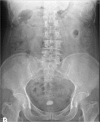Intravesical stone formation several years after hysterectomy: a case report
- PMID: 24088263
- PMCID: PMC4015828
- DOI: 10.1186/1752-1947-7-230
Intravesical stone formation several years after hysterectomy: a case report
Abstract
Introduction: Most bladder stones develop in patients with bladder outlet obstruction. Intravesical stone formation after surgery outside the urinary bladder is rare.
Case presentation: A 54-year-old Taiwanese woman with lower urinary tract symptoms following a hysterectomy 14 years ago presented to our hospital. The intravesical calculus had developed from non-absorbable sutures and hung on the dome of the urinary bladder. The stone and residuum of the suture were retrieved by performing an endoscopic procedure.
Conclusions: The presence of an intravesical stone should be suspected in patients with a history of hysterectomy who have symptoms in the lower urinary tract. A hanging stone on the dome of the urinary bladder implies that suture materials migrate into the urinary bladder. The complication can be prevented by the routine use of absorbable material and double-checking with cystoscopy.
Figures
Similar articles
-
Hanging bladder stone due to misplaced surgical suture several years after hysterectomy: A case report.Int J Surg Case Rep. 2021 Dec;89:106586. doi: 10.1016/j.ijscr.2021.106586. Epub 2021 Nov 15. Int J Surg Case Rep. 2021. PMID: 34826749 Free PMC article.
-
Vesicovaginal fistula with bladder and vaginal stone.Int J Surg Case Rep. 2022 Jul;96:107311. doi: 10.1016/j.ijscr.2022.107311. Epub 2022 Jun 14. Int J Surg Case Rep. 2022. PMID: 35803097 Free PMC article.
-
[Bladder stone secondary to prolene suture after gynecologic surgery].Urologiia. 2018 Dec;(5):92-93. Urologiia. 2018. PMID: 30575357 Russian.
-
Urinary bladder stones in women.Obstet Gynecol Surv. 2012 Nov;67(11):715-25. doi: 10.1097/OGX.0b013e3182735720. Obstet Gynecol Surv. 2012. PMID: 23151755 Review.
-
Bladder erosion of tension-free vaginal tape presented as vesical stone; management and review of literature.Int Urol Nephrol. 2007;39(2):453-5. doi: 10.1007/s11255-006-9080-y. Epub 2007 Feb 20. Int Urol Nephrol. 2007. PMID: 17310310 Review.
Cited by
-
Ureteric Suture Urolithiasis Following Open Emergency Ureteric Repair.Curr Urol. 2016 Feb;9(1):44-6. doi: 10.1159/000442850. Epub 2016 Feb 10. Curr Urol. 2016. PMID: 26989371 Free PMC article.
References
-
- Cursio R, Choquenet C. Iatrogenic bladder stone formation on absorbable suture 3-years after radical prostatectomy. Minerva Urol Nefrol. 2002;7:127–128. - PubMed
-
- Atakan RH, Kaplan M, Ertrk E. Intravesical migration of intrauterine device resulting in stone formation. Urology. 2002;7:911. - PubMed
-
- Demirci D, Ekmekçioğlu O, Demirtaş A, Gülmez I. Big bladder stones around an intravesical migrated intrauterine device. Int Urol Nephrol. 2003;7:495–496. - PubMed
LinkOut - more resources
Full Text Sources
Other Literature Sources



